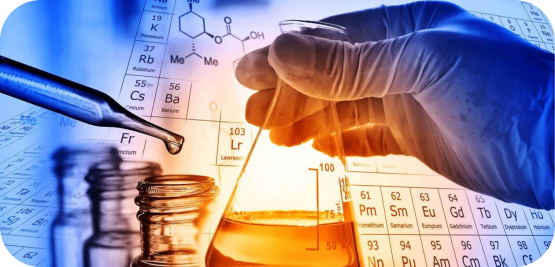Chemical Safety: A Core Pillar of Medical Device Evaluation
Chemical characterization and toxicological risk assessment are central components of the modern biological evaluation of medical devices. Regulators expect manufacturers to demonstrate a clear understanding of the substances present in their device, the potential patient exposure to those substances, and whether such exposures may represent any toxicological concern.
At Medistri, we support clients throughout this entire journey — from the Biological Evaluation Plan (BEP) and assessment strategy, to extraction design, chemical identification, and the final toxicological risk assessment required under ISO 10993.
From Extraction to Identification: ISO 10993-18 & ISO 10993-12
Every chemical risk assessment begins with generating robust analytical data.
ISO 10993-12 defines how medical devices must be selected, handled and extracted using scientifically justified conditions that reflect either realistic or exaggerated clinical exposure. Extraction ratios, solvent selection, temperatures and durations must preserve the chemical composition of the device while ensuring adequate recovery of potential extractables.
ISO 10993-18 then governs how these extracts are analysed and interpreted. Through techniques such as GC-MS, LC-MS and ICP-MS, a complete profile of organic and inorganic constituents is established. This analytical inventory becomes the foundation for the toxicological evaluation under ISO 10993-17:2023.
Screening Using the Toxicological Screening Limit (TSL)
The latest edition of ISO 10993-17 introduces the Toxicological Screening Limit (TSL), a pragmatic and conservative tool to determine whether a constituent is present at such low levels that it poses negligible systemic toxicological concern. The standard provides default thresholds for short-term and long-term exposure, which can be applied directly in most cases.
If the total quantity of a substance remains below the applicable TSL, and provided no exclusions apply, this screening step is sufficient to conclude that the constituent does not require further toxicological assessment.
When a substance exceeds the TSL, the evaluation moves into a more detailed phase.
TI, TCL and Patient Exposure: Bringing Toxicology Into Context
For constituents above the TSL, ISO 10993-17 requires defining a level of exposure that is considered safe. This may be a Tolerable Intake (TI) for systemic exposure or a Tolerable Contact Level (TCL) for local tissue exposure. These thresholds are derived from established toxicological data, adjusted using appropriate uncertainty factors to protect sensitive individuals.
In parallel, patient exposure must be estimated in a scientifically defensible way. ISO 10993-17 provides guidance on how to estimate exposure based on the extracted quantity, the number or surface area of devices involved, the intended clinical duration and relevant body-weight assumptions. Exposure must then be evaluated across the timeframes applicable to the device category — from acute to chronic use.
Margin of Safety: The Final Step in the Assessment
The Margin of Safety (MoS) compares the estimated patient exposure with the identified safe level (TI or TCL). A MoS of one or greater indicates that exposure to the constituent is unlikely to present an appreciable risk to health. If the MoS falls below one, further refinement or mitigation may be necessary, such as adjusting analytical assumptions, conducting additional testing, or implementing material or process changes.
A Cohesive, Regulator-Ready Workflow
Taken together, ISO 10993-12, ISO 10993-18 and ISO 10993-17:2023 form a continuous and coherent evaluation pathway. Extraction design feeds directly into analytical identification; toxicological assessment builds on the chemical data; and the final interpretation of risk integrates seamlessly into the overall biological safety evaluation.
This structure naturally closes the loop with the Biological Evaluation Report (BER) or Biological Safety Assessment (BSA). The conclusions drawn from TSL screening, TI/TCL establishment, patient-exposure estimation and MoS interpretation are integrated alongside the other biological endpoints — including cytotoxicity, irritation, sensitisation, pyrogenicity and any additional tests required by ISO 10993.
Medistri supports manufacturers at every stage of this process. Our team assists in developing the BEP, executing the chemical and biological testing strategy, generating regulator-ready analytical data, and compiling the final BER or BSA. This includes comprehensive in vitro testing (cytotoxicity, irritation, pyrogenicity), as well as coordinated support for in vivo studies when required by the standards. From extraction to toxicology, from bench-top assays to full biological safety evaluation, we provide a complete, scientifically robust pathway to compliance.
To learn more about our Chemical Characterization & Toxicological Risk Assessment, visit our website here or contact our team at contact@medistri.com.
— The Medistri Team
Frequently Asked Questions
1. What is the purpose of chemical characterization in medical device evaluation?
Chemical characterization identifies and quantifies the substances that can be released from a medical device under defined extraction conditions. This analytical inventory provides the foundation for assessing potential biological risks and ensuring patient safety in accordance with ISO 10993-18 and ISO 10993-12.
2. Why are ISO 10993-12, ISO 10993-18, and ISO 10993-17:2023 interconnected?
These standards define a sequential workflow: ISO 10993-12 governs extraction design, ISO 10993-18 describes analytical identification of constituents, and ISO 10993-17 establishes the toxicological evaluation framework. Together, they ensure that chemical and toxicological data are consistent, traceable, and scientifically justified.
3. How does the Toxicological Screening Limit (TSL) simplify risk evaluation?
The TSL acts as a conservative threshold to determine when a constituent’s concentration is too low to pose a toxicological risk. If a detected substance remains below its TSL, it can be excluded from further evaluation, streamlining the overall toxicological assessment.
4. When is a more detailed toxicological assessment required?
If a constituent exceeds the TSL, ISO 10993-17 requires determining a safe exposure level, either a Tolerable Intake (TI) or a Tolerable Contact Level (TCL), and comparing it with estimated patient exposure. This step ensures that any potential risk is quantitatively evaluated and properly mitigated.
5. How does Medistri support manufacturers through chemical and toxicological assessments?
Medistri provides an integrated approach encompassing extraction, chemical identification, and toxicological evaluation in compliance with ISO 10993 standards. By combining ISO 17025–accredited analytical testing with expert toxicological interpretation, Medistri delivers regulator-ready data that form the basis of the final Biological Evaluation Report or Biological Safety Assessment.
